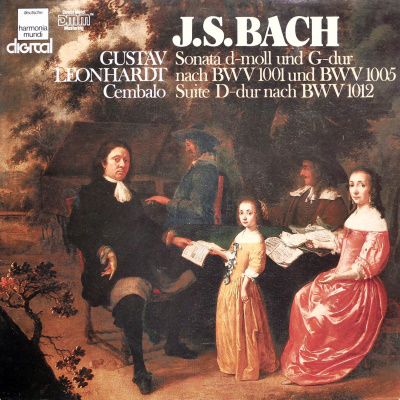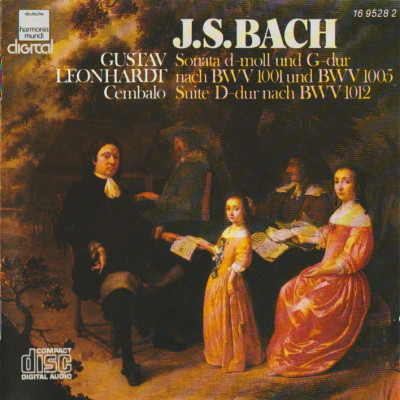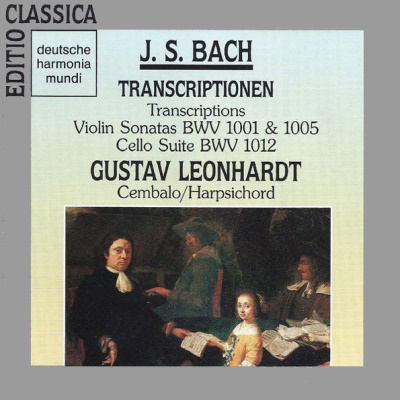 |
|
1 LP -
1C 067-16 9528 1 - (p) 1985
|
 |
| 1 CD -
567-16 9528 2 - (p) 1985 |
 |
| 1 CD -
GD 77014 - (c) 1990 |
|
TRANSCRIPTIONEN
BEARBEITET VON GUSTAV LEONHARDT
|
|
|
|
|
|
|
|
| Johann Sebastian
BACH (1685-1750) |
Sonate
d-moll - nach der Sonate Nr. 1
g-moll, BWV 1001, für Violine solo für
Cembalo |
|
13' 28" |
|
|
- Adagio
|
3' 21" |
|
A1 |
|
- Fuga.
Allegro
|
5' 00" |
|
A2 |
|
- Siciliano
|
3' 13" |
|
A3 |
|
- Presto |
1' 54" |
|
A4 |
|
Sonate
G-dur - nach der Sonate Nr. 3 C-dur,
BWV 1005, für Violine solo für Cembalo |
|
17' 16" |
|
|
- Adagio
|
3' 19" |
|
A5 |
|
- Fuga. Alla
breve
|
7' 59" |
|
A6 |
|
- Largo |
3' 18" |
|
B1 |
|
- Allergo assai |
2' 40" |
|
B2 |
|
Suite
D-dur - nach der Suite Nr. 6 D-dur,
BWV 1012, für Viola pomposa für Cembalo |
|
16' 47" |
|
|
- Prélude |
3' 34" |
|
B3 |
|
- Allemande |
3' 55" |
|
B4 |
|
- Courante |
1' 38" |
|
B5 |
|
- Sarabande |
2' 39" |
|
B6 |
|
- Gavotte I/II |
3' 12" |
|
B7 |
|
- Gigue |
1' 49" |
|
B8 |
|
|
|
|
|
Gustav LEONHARDT,
Cembalo (Nicholas Lefebvre, Rouen
1755; restauriert von Martin
Skowroneck, Bremen, 1984)
|
|
|
|
|
|
Luogo
e data di registrazione |
|
Doopsgezinde Gemeente
Kerk, Haarlem (Holland) - 1985
|
|
|
Registrazione: live
/ studio |
|
studio |
|
|
Recording
Supervision |
|
Dr. Thomas Gallia |
Klaus L Neumann | Benjamin
Bernfeld
|
|
|
Engineer |
|
Sonart, Milano /
harmonia mundi acustica
|
|
|
Prima Edizione LP |
|
Harmonia Mundi (EMI
Electrola) | 1C 067-16 9528 1 | 1
LP - durata 47' 53" | (p) 1985 |
DIGITAL
|
|
|
Edizione CD |
|
Deutsche
Harmonia Mundi | LC 0761 |
567 16 8528 2
| 1 CD -
durata 47' 53"
| (9) 1985 |
DDD
Deutsche
Harmonia Mundi | LC
0761 | GD 77014 | 1
CD - durata 47' 53"
| (c) 1995 | DDD
|
|
|
Cover Art
|
|
Familienbild. Gemälde
von Gillis van Tilborgh um
1625-1678. Mit freundlicher
Genehmigung des
Wallraf-Richartz-Museums, Köln.
|
|
|
Note |
|
Eine Coproduktion mit
dem WDR Köln. |
|
|
|
|
We tend
nowadays to view
arrangements of old music
somewhat sceptically, bieng
in general of the opinion
that one should respect the
form in which a work of art
was created. Such a maxim is
easy enough to follow when
applied to literature of the
fine arts: no one would
seriously have the audacity
these days to re-touch an
old master or to tamper with
the text of a great author.
As regards music, however,
the problem takes a somewhat
different shape: a piece of
music can be said fully to
exist only in this or that
performance, but each
performance, at the same
time, unavoidably adapts the
work in some way to the
present. The modern practice
of so-called "historical
performances" is an effort
to reduce this effect; by
attempting to reconstruct
the instruments and
performing practices of the
period in which older works
were composed, the
performers hope to achieve
the "original sound".
It might strike one as
paradoxial that this very
school of thought should
itself produce an
arrangement of a piece of
old music. In fact, however,
careful consideration shows
that it is completely
consistent with the attempt
to take the historical
presuppositions of a work
into account. The history of
music shows that our modern
view of the relation between
the musical text and its
interpretations or between
the original and its
arrangements or adaptations
is itself historically
conditioned and cannot
simply be applied
uncritically to the music of
other epochs. For example,
in order to perform the
thoroughbass or the
ornaments in a Baroque
composition one must not
only be versed in the
historical rules but must
also be a good improviser.
And often enough the sources
for a composition from the
17th or early 18th century
are such that a modern
editor will find it
impossible to say exactly
what the original version of
the work was. Experiences
such as these have led us to
realize that the full
dimensions of a Baroque
composition are not revealed
in any single version, no
matter how "original", nor
in any single
interpretation, no matter
how true to the work and
historically accurate - an
insight whose historical
relevance is documented by
the numerous arrangements
which Bach made of both his
own works and those of
others and which Bach's
contemporaries made of this
compositions,
The idea of making new
arrangements of Bach's works
did not, however, originate
with the relatively recent
historical movement. As
early as the 19th century,
there were numerous attempts
to "improve upon" or
"enrich" his compositions,
especially the sonatas and
partitas for solo violin.
The arrangers of that period
were, however, allowed
liberies which would be
unthinkable nowadays, as is
made quite clear by the
review of the "selected
Works from the solo violin
sonatas, arranged for
pianoforte by Joachim Raff"
which was published in 1869
in the "Allgemeine
musikalische Zeitung" in
Leipzig. The reviewer
remarks how the
accompaniment "heightens and
adorns" Bach's motives and
points out the "figures and
motives" added at places
which "Bach had intended to
be polyphonic but which are
not completely polyphonic
due to the limitations of
the instrument".
Nonetheless, at some points
the reviewer does exhibit
scruples about Raff's
methods. Having already
commented at the beginning
of his article that a
previously published
arrangement of the chaconne
from the 2nd partita betrays
an over-powerful urge to
turns this composition into
a brilliant piano piece
along modern lines, he notes
reproachfully: "One could
point out several individual
passages which are written
more in the modern way than
in Bach's style." It is
characteristic of our
modern-day approach to the
art of bygone eras that a
contemporary arrangement
should take as its model the
practices of Bach's own
period rather than
perpetuating this
19th-century tradition. This
model is clearly illustrated
here by the harpsichord
version of the first
movement of the third sonata
(BWV 1005), arranged by one
of Bach's contemporaries who
was a member of his own
circle. Comparing this
arrangement with the
original, we see that the
differences between the two
are essentially attributable
to the different tonal
properties of the
instruments. The
transposition, doubling and
augmenting of the intervals
between the parts are
related to the greater tonal
range of the harpsichord; on
th other hand, the fact that
long note-values are split
up into shorter ones, that
the chords are more dense
and that arpeggios are used
to bolster the harmonies are
due to the more limited
capacity of the keyboard
instrument for holding,
intensifying and modulating
the tone.
The problems posed by the
other movements differ in
accordance with the
character of the movement in
question: when transferring
a fugue, for example, from
the violin to the
harpsichord, the parts must
be elaborated; in a slow
movement, the harpsichord
version requires additional
contrapuntal and chordal
elements in ordder to
maintain the same density of
sound; and in fast
movements, changes in the
register and the chording of
the melody as well as
harmonic supporting material
provide that structural
orientation which the violin
can create by means of
dynamics and accentuation.
In what way, we may ask in
concluding, do these
arrangements reveal new
dimensions of Bach's work?
Most importantly, they
transcend the specific
limitations and qualities of
an individual instrument,
thus laying bare the musical
substance. At first glance,
it might seem impossible
that a given composition
should be capable of
bridging the differences
between the musical
presuppositions inherent in
the violin and the
harpsichord. Tha fact that
these works show it to be
possible after all is sue in
part to the adaptability of
musical compositions in the
Baroque period and in part
to the extraordinary quality
of Bach's art.
Kurt
Deggeller
|
  |
|
|